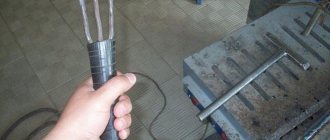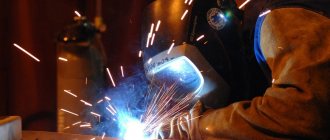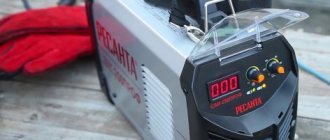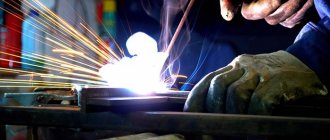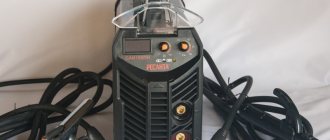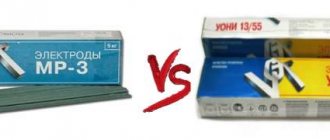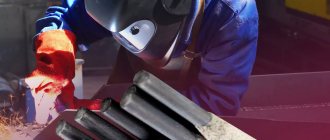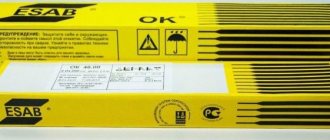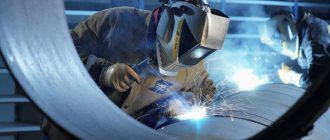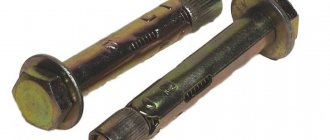ANO-21 electrodes: characteristics, decoding
Among the huge number of various electrode brands, ANO-21 electrodes are especially popular among both beginners and professionals. Such enormous popularity is not without reason, because ANO 21 electrodes can be welded in any spatial position and with any welding machine, be it a DC inverter or a transformer machine.
The main purpose of ANO-21 electrodes is welding of various structures made of low-alloy and carbon steels. You can also weld pipes with these electrodes; the only limitation is that electrodes of this brand are not intended for welding pipelines under pressure.
This article on the site about manual arc welding will discuss the main characteristics and application of ANO-21 electrodes.
Characteristics of ANO-21 electrodes
As mentioned above, the main application of ANO-21 electrodes was found in welding low-alloy and carbon steels. The electrodes discussed in this article can be used to cook in any position, metals of various thicknesses and even with an oxidized surface.
Technical characteristics of ANO-21 electrodes are as follows:
- Electrode diameter from 1 to 5 mm;
- The main coating is rutile;
- Recommended welding current - both alternating and direct current, of any polarity;
- Spatter coefficient - no more than 4%;
- Electrode consumption - 1.65 kg.
ANO-21 electrodes have an easily excited arc and stable combustion, which is why they have earned popularity among welders.
The interpretation of electrodes E46-ANO-21-d-UD looks like this:
- E46 - electrode type;
- ANO - brand of electrodes used;
- D—electrode diameter;
- U - for welding low-alloy and carbon steels;
- D - electrodes with a thick working coating;
- 43 is the time gap coefficient.
Specifications
ANO-21 are designed for welding metal structures of small thickness, small and medium-sized pipes operating under low pressure. In addition, such electrodes are suitable for producing small-sized welds. The technical characteristics of this brand of electrode are as follows:
- Metal thickness from 1 to 4 mm;
- Work on an oxidized surface;
- Rutile coating;
- Works in all spatial directions;
- Direct or alternating current at no-load voltage 50 volts;
- The diameter ranges from 2 to 4 mm.
Among the welding and technological properties of ANO-21 electrodes, one should highlight such as easy excitation, a stable arc, low spattering of the material and a high-quality weld. Other technical characteristics can be viewed in the tables on the websites of manufacturers and sellers of these devices.
Electrodes ANO-21 - reviews
In general, ANO-21 electrodes received positive reviews from both professional welders and newcomers to electric welding:
Welder Sergey from Samara : I always use ANO-21 brand electrodes in everyday life. What can I say, along with a reasonable price, quality and stability during welding are guaranteed. The slag flies off completely and quickly, the welding seam is smooth and neat, especially if you weld with an inverter using direct current.
Welder Vasily Petrov : ANO-21 electrodes work for me even on a homemade welding machine. What cannot be taken away from this brand of electrodes is “omnivorousness”. Only positive emotions from use.
Welder Alexander from Moscow : my experience of using ANO-21 electrodes turned out to be extremely negative. I purchased 3 mm electrodes under the Tigarbo brand, so while I was cooking, I didn’t give a damn. Not only does the weld seam form bubbles, but also metal mixed with slag comes out. The only plus is easy ignition of the electrodes and stable arc burning. I recommend using ANO 21 electrodes only for household needs.
Share on social networks
Advantages and disadvantages
Like any consumable material, ANO-21 welding electrodes have advantages and disadvantages. Let's start with the advantages:
- Available in the market and very popular;
- Low cost;
- Regardless of operating conditions, easy ignition of the arc is ensured;
- A light layer of slag is formed, which subsequently separates from the deposit without any problems during the control procedure;
- A sealed seam is created.
These advantages distinguish these electrodes from the line of consumables . But we should not forget about the disadvantages, including:
- Narrow scope of application;
- The coating is not reliable enough. Because of this, it is necessary to use additional fluxes and preparation of workpieces;
- The seams may not be strong enough, which is why they cannot withstand serious pressure and loads;
- Working with workpieces of significant thickness is unprofitable, since the result is a poor-quality seam.
We figured out the advantages and disadvantages of this consumable. But most of the disadvantages can be avoided if you use electrodes in a specific area and do not try for structures of significant thickness. And additional parts are relatively inexpensive and can be supplied to ensure the strength of the electrodes.
Features of the welding process
Welding is carried out using AC or DC power sources, and in the latter case the polarity does not matter.
AC devices must operate at an idle voltage of 50 V with a deviation of no more than 10% in one direction or another. A special feature of preparing the edges of products for welding is that they do not have to be cleaned to a metallic shine. Welding can be carried out not only with a short arc, but also with a long one. The dimensions of consumables and welding modes are indicated in the table:
| Thickness of welded metal, mm | Recommended electrode Ø, mm | Electrode length, mm | Welding current (A) when welding in position | ||
| 0,5 | 1,6 | 250 | lower | vertical | ceiling |
| 50 ÷ 75 | 50 ÷ 70 | ||||
| 1,0 | 1,6÷2,0 | 50÷90 | 50 ÷ 90 | ||
| 2,0 | 2,5÷3,0 | 300 | 50÷140 | 80÷130 | 70÷120 |
| 3,0 | 3,0÷4,0 | 300; 350 | 90÷200 | 100÷180 | 90÷180 |
| 4,0 | 5,0 | 400 | 160÷240 | 140÷220 | 130÷220 |
How to weld is shown in the video:
.
The moisture content in the electrode before use should not exceed 0.9%, therefore, during long-term and improper storage, it is recommended to calcinate them at a temperature of 120 °C for at least 40 minutes.
User reviews of ANO-21 electrodes speak in favor of such consumables, provided that they are not counterfeit. Therefore, carefully read who the manufacturer is and buy products that have a quality certificate. Welders write about the ease of arc ignition, the reliable connection of products made from simple steels, and note the reasonable cost.
General information
First, let's look at the technical characteristics of the ANO-21 brand. Produced according to GOST 9467-, type E46. The coating is rutile, which stabilizes the arc and reduces the pulverization of the metal.
So, when working with ANO-21, we have a stable arc and low spatter. The rutile coating prevents oxidation processes from starting by protecting the weld from interaction with oxygen.
It is possible even for a non-professional to obtain a quick and even seam with minimal likelihood of pores forming in it. About 1.5 kilograms of electrodes are needed per hour, which indicates the high productivity of the process.
Analogues of this type can be ANO 4, MR-3, OZS-6 or OZS-12. Usually they stop at the ANO 21 3mm and 4mm types. Reasonable prices for rods from manufacturers LEZ, ChZSM, which will cope with welding at home and for those trying their hand at this business.
Explanation of the symbol
Electrodes of the ANO-21 brand are specially marked in the technical documentation, drawings and packaging. It consists of letters and numbers:
| E46-ANO-21-Ø-UD |
| E 43 2(3) - P 11 |
or
| E46-LEZANO-21-Ø-UD |
| E 43 1(3) - RC 13 |
- E46 – type according to GOST 10051-75 (E – electrode, 46 – weld strength limit, indicated in kgf/mm²);
- ANO-21 is a brand (sometimes they put letters in front of it that indicate the manufacturer of the electrodes). ANO stands for Academy (A) of Sciences (N) of General Purpose (O), the number 21 is the number;
- Ø – diameter indicated in mm (1.6; 2.0; 2.5; 3.0; 4.0; 5.0);
- U – purpose of the consumable material (for welding carbon and low-alloy steels);
- D – type of coating (thick);
- E 43 2(3) or E 43 1(3) – a group of indices indicating the degree of corrosion resistance of the seam and the type of test, the maximum temperature the seam can withstand in terms of heat resistance and heat resistance;
- R or RC – type of coating (R – rutile, RC – combined, rutile-cellulose);
- 11 or 13 – universal for welding in all possible positions (11) and in all positions, including horizontal (13).
Application and characteristics of electrodes
The rods are used for structures and products containing carbon and low alloying levels. The permissible strength of materials is 450 MPa. Welding can be done in different positions and from different currents.
Options:
- coefficient surfacing: 8.3 g/Ah;
- productivity: 1.4 kg/h;
- consumption: 17 kg per 1 kg of deposited metal;
- coating: rutile + carbonate;
- diameter: 3 - 5 mm.
Different currents should be used for different electrode diameters. For 3 mm: 80 - 150 A; for 4 mm: 120 - 180 A; for 5 mm: 150 - 230 A.
Using “ANO-4”, contaminated and rusty metal can be welded. Damage and oxidation on the edges is acceptable.
The rods feature easy arc ignition, which makes them useful for beginners.
When a weld is produced, a small amount of hydrogen is formed in it, which prevents the formation of cracks and pores that can have a destructive effect on the joint.
Electrode storage
The products are supplied in packaging and a special film that protects the products from moisture. However, in order for the electrodes to remain in working condition for a long time, storage conditions must be observed. They must be in a dry place at a temperature not lower than 15°C. It is very important to prevent them from getting wet or excessive humidity in the room. Also make sure that nothing falls on them and does not cause mechanical deformation. Otherwise, the coating will be damaged and it will be impossible to use the electrodes.
If it turns out that the electrodes are wet, they should be dried. This is done in a special oven. Place them there for half an hour. The calcination temperature should be 150 - 160°C.
Design and main characteristics
Structurally, the electrode is a metal rod of a certain diameter and length, made of Sv-08 or Sv-08A welding wire, which is coated with a rutile or rutile-cellulose type coating with high sanitary, hygienic and technological properties.
Figure 1 — Electrodes ANO-21
They are manufactured by various domestic manufacturers in accordance with the requirements of GOST 9466-75, GOST 9467-75 and according to the technical specifications of the manufacturer registered in Gosstandart. In addition, they comply with the requirements for such products as set out in the European and international standards ISO 2560:2009, DIN 1913-1984 and AWS A5.1. Supplied in cardboard packages weighing 1.0, 2.5, 3.0 and 5.0 kg. Such packages should be stored in rooms where the temperature does not fall below 15 °C.
Technical characteristics of ANO-21 are indicated in the table:
| Name | Unit | Index |
| Capacity (for Ø 3 mm) | g/min | 14 |
| Deposition factor | g/Ah | 7,0÷8,0 |
| Consumption of electrodes per 1 kg of deposited metal | kg | 1,65 |
The electrode material participates in the formation of the weld and ensures easy separation of the slag crust. The chemical composition of the deposited metal after its cooling is indicated in the table:
| Item name | Percentage, no more |
| Carbon | 0,1 |
| Manganese | 0,5÷0,8 |
| Silicon | 0,3 |
| Sulfur | 0,040 |
| Phosphorus | 0,045 |
The mechanical properties of the seam after welding ANO-21 are indicated in the table:
| Indicator name | Unit change | Quantity, no less |
| Tensile strength | N/mm² | 450 |
| Relative extension | % | 18 |
| Impact strength | J/cm² | 78 |
